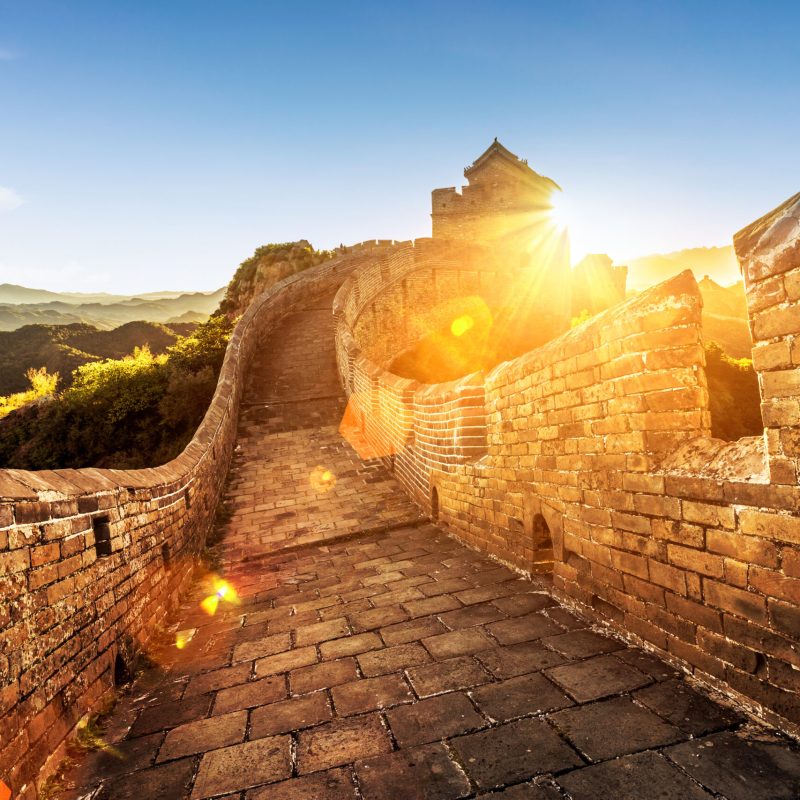
It’s a bucket-list, world-wonder destination on many of our travel radars: The Great Wall of China needs no introduction. The massive border fortification is hundreds of years old and stretches for thousands of miles across northern China. Built to keep out invaders, the Great Wall is an incredible example of military architecture, and it is instantly recognized by people all over the world. Here are a few fascinating facts about this one-of-a-kind, unforgettable site.
Videos by TravelAwaits

1. It’s Not Just One Wall
Contrary to popular belief, the Great Wall is actually a system of walls, some built parallel to each other for greater strength and security. The best-preserved and most extensive sections were constructed during the Ming dynasty (1368–1644) and stretch nearly 5,500 miles across the Chinese countryside. The Great Wall and its sections were built along natural features including trenches, ravines, and hills. In the better-preserved sections, you’ll also see — and can explore — military additions including watchtowers, fortresses, barracks, and battlements where troops would gather when invaders closed in. Top sections to consider for your visit include Mutianyu, 40 miles north of Beijing, with its gorgeous natural scenery; Shanhaiguan Pass, 9 miles northeast of Qinhuangdao City, with its magnificent gates; and Jinshanling, with its terrific hiking and awe-inspiring vistas.

2. Thousands Of Miles Have Been Lost
While the Great Wall stretches for more than 13,000 miles, some of that length includes earthen mounds and branches instead of solid brick and stone walls. Time has not been kind to the archaeological wonder; erosion, earthquakes, and even vandalism have taken their toll, especially on the older sections. It’s hard to believe, but part of the reason that portions of the Great Wall are crumbling is a government missive issued by Mao Zedong in the 1950s. The Communist leader actually encouraged farmers and those living in the countryside to take down parts of the Great Wall and use the stones and bricks to build their homes. It’s estimated that more than 1,200 miles of the Great Wall have been lost, and recent surveys show that only about 8 percent of the landmark is in good condition. The Chinese government is putting protection action items in place, including crowdfunding campaigns for restoration efforts at the UNESCO World Heritage site.

3. Being On The Construction Crew Was A Punishment
While one might think that working on the Great Wall was a privilege and honor, that was most certainly not the case. Emperor Qin Shi Huang ordered the wall built around 221 B.C., and he knew he would need vast amounts of manpower to get the job started, so convicts were sentenced to hard labor on the site, as were peasants and enemies of the dynasty. Soldiers were forced to help construct the Great Wall as well as defend it. Future emperors continued Qin Shi Huang’s practice of forced labor to keep the construction going. The workers hauled massive rocks and stones, mixed enormous amounts of mortar, and dug foundations. It was backbreaking, bone-crushing work, and many men compelled to work on the site paid the ultimate price to finish the job. An estimated 400,000 people died during the construction process, an astounding and shocking number.

4. It’s Called “The Longest Cemetery On Earth”
And what happened to the unfortunate souls who died at the Great Wall? Well, it isn’t called the “longest cemetery on Earth” for nothing. As men died there, many were simply entombed in the foundation as their colleagues kept working around them. The families and friends of those who passed away would come to the site to mourn, some unsure of their loved ones’ final resting places. They would often bring caged roosters with them in the hope that the crowing would keep their loved ones’ spirits awake. One of the most poignant legends is that of Meng Jiang, who traveled to the Great Wall to visit her husband there. When she discovered that he had died and was buried in the stone foundation, her tears caused the wall to collapse, exposing her husband’s bones for proper burial. It’s a haunting reminder that as great and wondrous as this landmark is, it was built at a terrible cost.

5. An Unlikely Ingredient Holds It All Together
When you visit the Great Wall, especially the sections that have been maintained, you can’t help but wonder how the stones have stayed together for so long. Yes, there are preservation efforts ongoing and underway, but it turns out that a staple of Chinese cuisine also played a role. Scientists say that during the Ming dynasty, workers incorporated sticky rice into the mortar that held together sections of the Great Wall. That mortar bound the bricks so tightly that even today, hundreds of years later, weeds still don’t grow in between them. It turns out that an ingredient in sticky rice porridge, amylopectin, formed a microstructure with the calcium carbonate in the mortar, giving it superstrength. Chemists say the sticky rice is what has allowed sections of the Great Wall to withstand earthquakes and other natural disasters for generations.

6. It Didn’t Do What It Was Supposed To Do
There’s no doubt that the Great Wall is the pride of China, and for good reason; it’s an amazing feat of architecture, and parts of it have survived for centuries. What’s up for debate, however, is how well it defended the country from invaders from the north. The tribes of the steppes wanted what their southern neighbors had: a better range of agricultural options and finer textiles given their proximity to the Silk Road. Large armies and smaller groups of nomads continually attacked the Great Wall. Some succeeded, and others were quashed. While the Ming dynasty further fortified the structure, the Great Wall didn’t really help to keep the marauders out. After two centuries of war with the Manchurians — and many over-the-wall skirmishes — the Ming dynasty fell in the middle of the 17th century. The Manchus ruled China until the early 1900s and expanded the nation northward, rendering the Great Wall irrelevant as a defense system. All in all, the Great Wall was an impressive but imperfect solution.

7. You Can’t See It From The Moon
We’ve all heard it: The Great Wall is the only man-made object on Earth that you can see from the moon (or from space). Chances are, we’ve all bought it. Trouble is, it’s a fabrication! China’s first man in space, Yang Liwei, said he couldn’t see the Great Wall when he was in space in 2003. Subsequent observations and photos from the International Space Station proved that, if anything, it’s extremely difficult to see the Great Wall from a celestial vantage point. According to NASA, the Great Wall is made from the same materials as the surrounding land, so it’s difficult to perceive with the naked eye from space. So, while this is a lovely legend, it just doesn’t shake out.

8. You Can Run A Marathon On It
If you’re going to the Great Wall, but a leisurely hike isn’t your style, you can actually race on sections of the famed fortification! Established in 1999, and held each May and capped at 2,500 runners, the Great Wall Marathon is widely regarded as one of the most challenging races in the world. Runners race up hills, through forts, down stairs, and through small villages. The race begins at Huangyaguan Gate, about 60 miles from Beijing. Avid runners call the event a true bucket-list experience, and it’s easy to see why. If a marathon isn’t in your wheelhouse, there’s also a half-marathon (and even a 5-kilometer fun run!).
